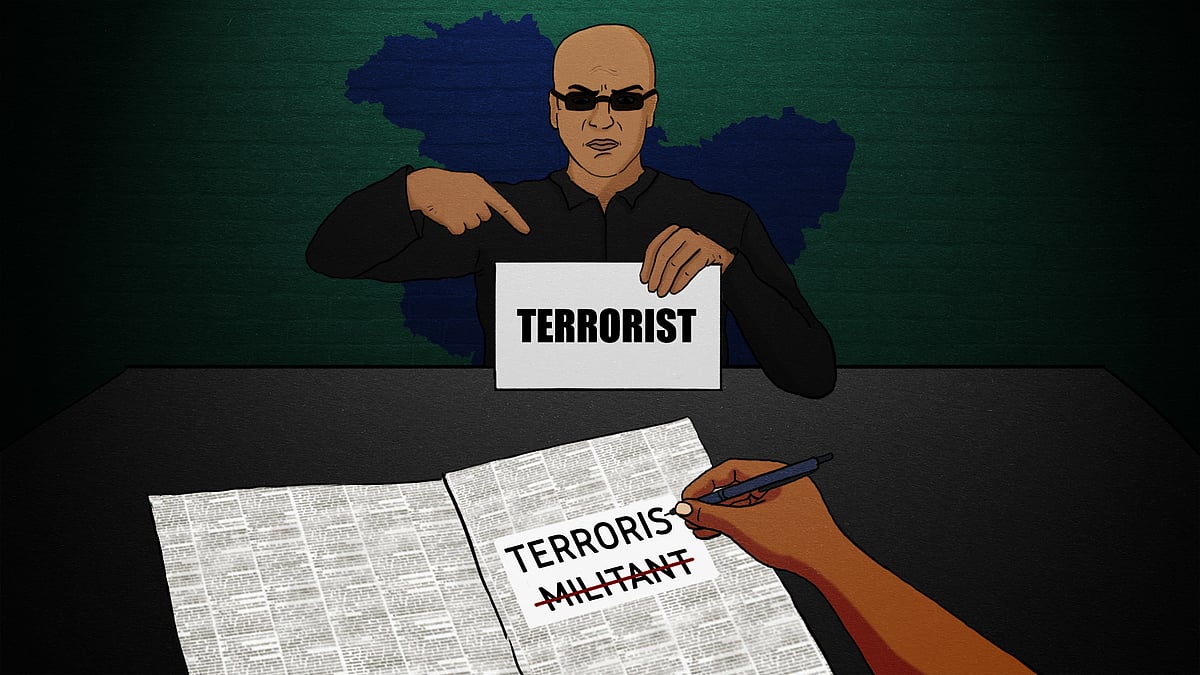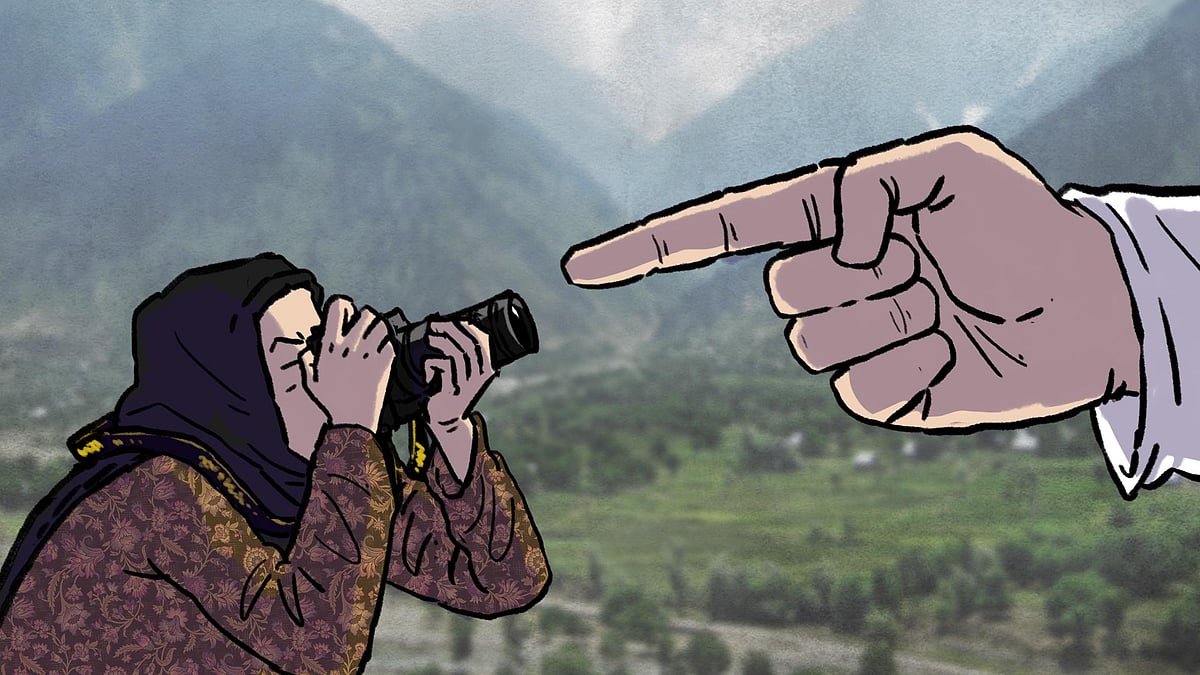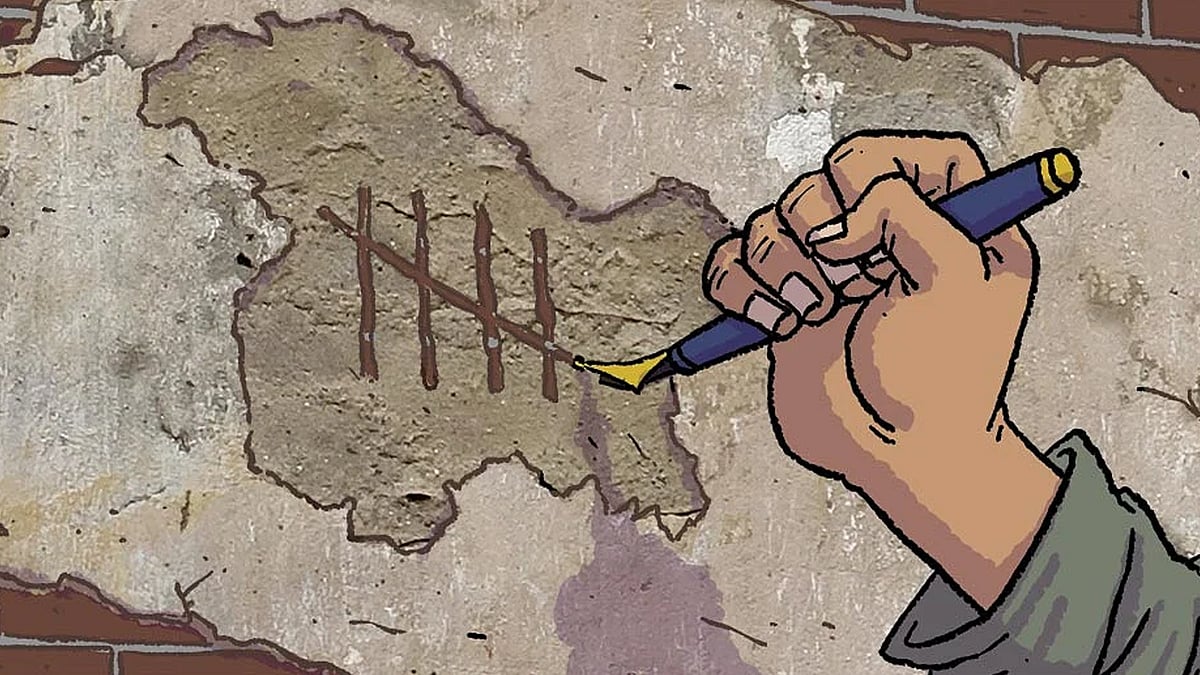Kashmir governor’s public relations blitz leaves the press in tatters
Newspapers now publish little more than government handouts about Manoj Sinha and his supposed feats.
In Kashmir’s frontpage headlines, there’s just one newsmaker. His utterances and field trips are not only prominently placed, some newspapers dedicate nearly all their pages to his feats and often print several pictures of his on the same page. Glance at Kashmir’s newspaper stands and you won’t miss the multitude of mastheads – there are 171 titles registered in Kashmir currently and 180 in Jammu – but look closely and you will see that “news” on most days is almost identical.
Across papers, there are identical stories with similar headlines – sometimes kickers for added emphasis and no questions asked – studded with pictures of the newsmaker: Jammu and Kashmir’s lieutenant governor Manoj Sinha.
Since his appointment last August, Sinha’s mugshot and stated accomplishments have dominated newspapers, in ads but also columns otherwise meant for news, papering over the ground realities in Kashmir.
The reason: Kashmir’s media houses, which survived the conflict for decades, have been brought to heel by increasingly authoritarian measures since the last elected local government was felled in 2018. The result is an unprecedented limelight on Sinha and his persona that pales in comparison with coverage of even prime minister Narendra Modi.
No questions asked
On August 5, the second anniversary of the Indian government unilaterally abrogating Kashmir’s residual autonomy and Sinha completing a year as the union territory’s administrator, most dailies failed to note the occasion. Instead, Rising Kashmir and Kashmir Images in English and Tameel-i-Irshad and Aftab in Urdu, among the top papers, had Sinha’s face greet readers from full frontpage ads announcing a new film policy.
On the ground, the day was marked by the police breaking open shops in Srinagar’s Lal Chowk and a suspected bombing in the city. The papers didn’t report any of this on their websites or on social media that day, except Kashmir Observer.
The next morning, reports on the blast were tucked away in small boxes on frontpages, overshadowed by multicolumn briefs on the Sinha administration’s assertion of ushering Kashmir into an era of peace and progress.
Kashmir Observer reported, on the third page, that “a battery of cops Thursday enforced ‘normalcy’ in Lal Chowk” by forcing open shops. Greater Kashmir had two lines, attributed to traders, about the police’s vandalism. And despite the availability of video evidence to the contrary, its headline said, “Day passed off peacefully: Police". Kashmir Images reported the incident in similar wording with a neutral headline. Rising Kashmir briefly mentioned the blast but not the police’s vandalism while Kashmir Monitor did not report either incident.
The papers had one thing in common, though: Sinha announcing that he’s “committed to making Panchayati Raj institutions more empowered”. Most of the leading newspapers placed this handout by the Directorate of Information and Public Relations on top.
On August 10, Sinha visited the Jhelum river in Srinagar and the DIPR handout again made frontpage news the following day. On the eve of India’s 75th independence day, a half page ad announcing the fifth episode of Sinha’s talk Awaam Ki Awaaz, meaning, without a hint of irony, the voice of citizens, appeared on the frontpages of Images, Monitor and Rising, among the top English newspapers eligible for J&K government ads, which Greater and Reader are barred from receiving since 2019. The lieutenant governor’s picture filled a quarter of the frontpage. The remaining space either had Sinha’s comments, along with another picture of him, or those of his administration.
On August 15, the practice continued of filling most pages with the government’s handouts alongside ads of Sinha greeting the public on the occasion. The day's top news was a brief hailing the new film policy, the administration issuing directions “for the preservation and protection of Kashmiri migrants' immovable properties and the removal of any encroachments”, and his Independence Day speech. Monitor and Rising published the transcript of the speech on full pages.
Again, what was common was the dire lack of reportage. None of the top papers even carried a critical examination of the new film policy.
On August 9, Rising Kashmir online editor Irfan Amin Malik had been detained by the police for over five hours for a critical tweet about the film policy that was online for barely a few minutes. The organisation is yet to comment on its employee’s treatment.
New media policy
Armed with a battery of public relations officials led by his trusted aides and guided by a media policy described as ”Orwellian”, Sinha has mounted a public relations campaign without parallel in J&K’s recent memory.
In October 2020, Sinha’s administration hired two media advisors, Yatish Yadav as a senior media consultant with a monthly salary of Rs 1,50,000 and Dushyat Kumar Rai as a media consultant for Rs 80,000 a month. They reportedly have their jobs as long as Sinha has his and they are entitled to perks, including travel allowance and accommodation, on a par with officials of additional secretary and deputy secretary ranks, respectively.
Yadav didn’t respond to requests for an interview. Rahul Pandey, who was brought from Uttar Pradesh in March to head the DIPR, didn’t respond to requests for an interview.
In the face of Sinha’s public relations blitz, Kashmir’s newspapers, English and Urdu, have been reduced from serving as watchdogs holding power to account to a reflection of Sinha’s perception of himself. Almost every day now, they describe a Potemkin village on the path to development.
The focus on “development” is enshrined in the new media policy, announced last year, which seeks to not only define who qualifies as a journalist but even what constitutes news, giving adjudicating powers to bureaucrats and not media professionals. Among its stated objectives: “foster a genuinely positive image of the government based on performance” and “create awareness among the people on government policies, plans, programmes intended for public welfare and socioeconomic development”.
The policy’s working idea, it seems, is to be a magic bullet to quell discontent among the people by filling newspapers with details of government initiatives, but without nuance or any explanation of how they might work. Instead, the papers have to rely solely on government disclosures and claims about how a scheme might benefit the public.
This thrust of the media policy to create a "favourable" image of the government is rooted in its assumption that the people need not understand the governance process. It is enshrined in one of the policy's guiding principles: “Ensuring that a message has a reasonable level of value for the recipient is paramount to gain public attention and interest. While government operating procedures hold little value to the public, how those procedures affect the daily lives of people are very important for them. Therefore, information will be structured with the public impact as its basis. People should know about the execution of development projects, welfare measures, schemes and new initiatives taken by the government for their welfare and how their lives are going to get impacted by the same.”
Another stated objective is to “thwart misinformation, fake news and be alert to any attempts to use media to incite communal passions, preach violence, or to propagate any information prejudicial to the sovereignty and integrity of India”.
The lack of news coverage and the administration’s continued stonewalling of reporters working with media outlets outside Kashmir – who ask questions or want to understand the process, only to often be derided by the administration officials – has led to an information vacuum which is being filled by DIPR handouts.
So much so that the weekly tabloid Kashmir Life, once a chronicler of the region’s history, has been publishing weekly briefs titled “Governance Initiatives”. In May, when the press cheered a local nonprofit and the Srinagar district magistrate’s initiative to set up a Covid care facility, the administration sought to appropriate the credit for Sinha’s “directions”.
Several media houses have resorted to treating every utterance of Sinha’s as newsworthy. Regardless of the subject of his comments or assertions, his mugshot invariably adorns the header. And the language used by the newspapers, in contrast to just a few years ago, reasserts notions of “national integrity”.
It’s a frustrating situation for many journalists. “Is it possible that nothing wrong has happened since the new LG has come?” asked an exasperated senior editor at a leading newspaper.
He gave up trying to cover after attempts to persuade his chief editor proved futile. “Newspapers have become an extension of the DIPR. Earlier there was some semblance of news gathering, now they meddle with what goes on page 1,” he rued, meaning administration officials.
The dispensing of advertisements and their publication by papers isn’t a simple transaction either. The dimensions and placement of ads are pre-decided by DIPR and refusal or delay in publication – say, on account of concerns over their content – might cost the papers revenue and even future ads.
An editor explained how the administration is using the carrot-and-stick of ads to cleanse frontpages. Sometimes, they “get calls” from government officials he wouldn’t name if they “carry critical news”, he said, requesting anonymity for fear of reprisals. “They tell us why we carried that news and offer ads to ensure that tomorrow’s editions are devoid of critical headlines.”
In his image
A spiral of silence began in Kashmir with the felling of the last elected government and deepened after August 5, 2019. It has now reached the climax, defanging newspapers and replacing their coverage of the administration with self-congratulatory briefs.
The exercise of documenting history as it unfolds – as the media is meant to – has been replaced by top newspapers projecting a larger than life image of Sinha. “People like me have stopped looking at newspapers because it’s all predictable. There’s nothing new in them,” complained Noor Baba, a political analyst in Srinagar. “Another important pillar of democracy has lost its credibility in the process. Now the people don’t trust the media.”
What makes this a rather bizarre state of affairs is that Sinha is a Bharatiya Janata Party leader from Uttar Pradesh, with seemingly no long-term political stake in the region he now governs. He’s also only the second politician, after his predecessor Satyapal Malik, appointed by the Indian government to administer J&K.
Sinha’s public relations push can perhaps be explained by the fact that he “is a politician with big ambitions. He is his own individual”, Baba argued. It is an anomaly however, he noted, “because in the present dispensation, Modi is the centre of everything”. Not least in Kashmir, which his government demoted to a union territory in August 2019.
“Maybe he has long-term ambitions,” Baba speculated, referring to Sinha. “He probably has his own ambitions and grievances and that’s why he wants to project his own image. That might not help him in Kashmir, but it will help him in the prospective political life wherever he is in future, perhaps Uttar Pradesh.”
No matter Sinha’s motivations and calculations, his administration is likely doing lasting damage to Kashmir’s press. Which has costs at a time when the Indian government is seeking to reinvent J&K. “The media could have been another bridge, the expression of popular feelings and to gauge public opinion,” Baba explained. “But it’s not there.”
On the ground, Baba pointed out, “alienation has reached a climax”. On August 15, he said, “the administration ensured that the national flag is hoisted on all government buildings but I am surprised to see the unprecedented public bandh in all parts of Srinagar. The people may not be vocally expressing themselves but they are subtly expressing themselves.”
The same day, Kashmir’s leading papers carried a piece of irony. The previous day, their editors and publishers had been stunned to receive “complimentary ads” – unlike how it sounds, they were meant to be published free of cost to the DIPR – that portrayed the newspapers, seemingly on their own, greeting their readers on Independence Day.
***
Independent media has a critical role in sustaining democracy, telling stories that need to be told and asking questions that demand answers. Support independent journalists by paying to keep news free. Subscribe to Newslaundry today.
 Kashmir’s press is being forced to replace ‘militant’ with ‘terrorist’. It’s dangerous
Kashmir’s press is being forced to replace ‘militant’ with ‘terrorist’. It’s dangerous ‘Intimidation is in the air’: How the Indian state is suffocating Kashmir’s journalists
‘Intimidation is in the air’: How the Indian state is suffocating Kashmir’s journalists Panopticon of fear and rumours: Inside Kashmir’s media centre during lockdown
Panopticon of fear and rumours: Inside Kashmir’s media centre during lockdown
 ‘Sarkari bulletin’: How the Indian state has used fear and ad money to hollow out Kashmir’s press
‘Sarkari bulletin’: How the Indian state has used fear and ad money to hollow out Kashmir’s press